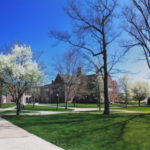3 Statistics that Shouldn’t Matter in Choosing Colleges (and why they don’t)
Choosing a college can be a pain — there are so many objective facts and figures that colleges throw at you, and on top of that you have to keep track of your own tastes and preferences. It’s a lot to handle and a weighty decision to make; where you end up going will be where you spend the majority of the next four years of your life, possibly more.
The good news is that not all of these numbers that colleges like to publicize are necessarily useful to you, the aspiring undergraduate student. We’ve selected three often-emphasized statistics below, and we’ll explain to you why they shouldn’t factor into your decision.
Class size
This is a statistic that colleges really like to advertise — if 60% of all classes have fewer than twenty students, it implies that you’ll probably have classes that are small, intimate gatherings where professors will get to work with students one-by-one. At least that’s what it sounds like, right?
Well, not really, and here’s why you should take that number with a grain of salt.
Different majors.
First of all, that ratio is an aggregate across all departments and majors at that college, and oftentimes, you’ll find that because of logistical reasons, class sizes actually vary widely across different academic disciplines.
Since most science and math-based courses teach the same standard material and evaluate students based on a set of objective criteria, it’s easier to have larger class sizes (usually in the hundreds) for STEM courses. However, for humanities courses where professors have to evaluate each student subjectively, class sizes tend to be smaller so that professors can dedicate the time to understanding the personal viewpoints of each student and assigning a final grade accordingly.
Upper-level classes vs. lower-level classes.
Also, class sizes tend to get smaller as they get harder in difficulty — a freshman year intro to chemistry course is going to be much, much larger than a physical chemistry course in nanomaterials, intended for seniors. This is because many different (but conceptually related) academic departments typically have the same introductory classes as prerequisites for their more specialized classes.
For example, chemistry majors, biology majors, nutritional science majors, and plant science majors may all need to take Chemistry 101 because all their majors require the analytical skills and fundamental knowledge taught in that class. But as these students advance in their majors, they begin to specialize more and more, resulting in smaller and smaller classes as they near graduation. As a result, freshman classes tend to be some of the largest classes that a college offers.
Flexibility.
Most colleges will also expand or reduce class sizes according to demand and interest — if a class is immensely popular, the teaching staff may ask for new openings in order to accommodate all the students who want to take the class. On the other hand, some classes covering more niche subjects almost never fill up completely simply because of their highly specialized nature. So it’s not unusual to see some courses with an enrollment size that you can count on one hand, either.
All that is to say that in regards to your college experience as an individual student, class size isn’t really a college-specific factor that will affect your experience. What major you are and what academic subjects interest you will have a much bigger impact on the average size of your classes, and these trends are pretty consistent across different universities.
Percentage of full-time faculty
This is largely an indicator of a college’s success as a research hub and academic think tank, and that’s where this statistic holds weight. Graduate students who intend to pursue their master’s, doctorate, or who want to become academics themselves are the ones that this , this figure is mainly targeted towards.
But undergraduates? That’s a different story.
Not everyone who teaches is a “professor.”
At most colleges, not all faculty are created equal; in fact, not everyone who teaches can actually be called a professor. There are junior lecturers, senior lecturers, associate professors, assistant professors, full professors — the titles might vary from institution to institution, but the main difference here is that some of these titles come with tenure and others don’t. Typically, only faculty members with tenure can be called “professor,” and those are considered “full-time” faculty.
The faculty members who teach, but don’t have tenure? A decent number of them are grad students who are working on their degrees, and another sizable portion of them are postdoctorates looking to gain a full-time professorship.
Both of these demographics are important to a college because these people are the people who will become the college’s academics and contribute to its influence in the research field, and while they’re not full tenured professors yet, the college will often put them to work teaching undergraduate classes in the meantime.
So…who’s actually teaching?
Because of this, at a lot of colleges, a significant fraction of undergraduate classes will be taught by faculty members that are not full-time. This way, it’s more cost-effective for the college, as hiring untenured faculty to teach classes is often cheaper, and it’s a good way for grad students and postdocs to refresh their knowledge and put it to good use.
Full-time faculty do teach undergraduate classes, but this is usually a choice on the part of the professor (being tenured comes with its perks); by the time a professor is tenured, research generally is one of their more important priorities and many professors often want to dedicate more time to their graduate and postdoc advisees than they do to teaching undergraduates. However, this is by no means a hard and fast rule, and there are many professors who love to teach both undergraduates and graduates.
Most colleges follow this system, so regardless of the number of full-time faculty at an institution, the ratio of tenured to untenured faculty you’ll encounter as an undergraduate will be about the same at any college.
Student-faculty ratio
We’ve already established that class size doesn’t really matter across different schools, and that’s one of the reasons why you’ll never feel the full difference between a nine-to-one student-faculty ratio and a seventeen-to-one student-faculty ratio.
Your major and the classes you choose to take will affect your amount of contact with faculty members more than anything else could, so the student-faculty ratio that colleges love to brag about will impact you less than you think.
You’re in control.
The amount of contact you have with faculty members also rests upon one major factor — yourself. This is because the nature of most student-faculty interactions at college are student-initiated.
Teaching staff will always have office hours during which they welcome their students to come to them and ask questions or discuss the subject matter in class. That’s often a good time to go in and get to know your professors, and possibly strike up a conversation.
In more discussion-based classes, you’ll leave more of an impression on the faculty if you choose to participate, and participate well. Almost everything in relation to student-faculty interactions is voluntary on the student’s part; you’ll never be asked to do anything you don’t want to.
Anyone can be a standout.
So that means that even if you’re part of a three-hundred-person class, it’s possible to stand out and be noticed if you make the effort. But on the other hand, it also means that you can choose to be completely nondescript in a ten-person class. For the most part, it’s what you choose to make of it.
Because of this, the student-faculty ratio is usually not a number that can tangibly affect your college experience. Many colleges do like to emphasize because of its importance in evaluations for college rankings, but ultimately your relationships with your professors are what you make of them.
Colleges don’t exclusively advertise themselves to undergraduate students — they also have to worry about the ranking services (who have their own set of idiosyncratic standards for a “good” college) and attracting talented graduate students and postdoctorates.
As a result, the numbers they put on their websites and flyers aren’t intended only to win over undergraduates. The best way to truly know if a college is right for you is to experience the college itself in some way, shape, or form — a visit or a chat with a current student or alum is often the best way to get a feel for what a college is really like, and can offer a more relevant feel that can help you make your decision.
Curious about your chances of acceptance to your dream school? Our free chancing engine takes into account your GPA, test scores, extracurriculars, and other data to predict your odds of acceptance at over 500 colleges across the U.S. We’ll also let you know how you stack up against other applicants and how you can improve your profile. Sign up for your free CollegeVine account today to get started!

